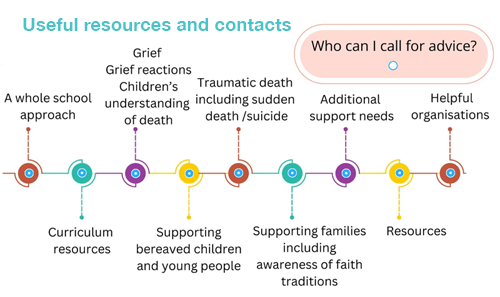Supporting children and young people through bereavement

This interactive tool (thinklink) guides practitioners to a range of resources, helplines and organisations.
An accessible version of the thinglink is available as a Powerpoint presentation: 'Bereavement resource (584 KB)
Many children and young people experience the death of a close family member during childhood [1]. By age ten 62% of Scottish children will have lost a close family member. Children born into the lowest income households are at higher risk of being bereaved of a parent or sibling than those born into higher income households [2].

This thinglink will explore how a whole setting approach to bereavement can be taken. It shares examples of how death and bereavement can be part of the curriculum.
There are sections that look at children’s understanding of death, as well as reactions to grief, across the developmental stages.
The next area explored is how we can support children, young people and their families. Consideration is given to traumatic deaths including sudden death and suicide.
Bereavement as an additional support need is highlighted.
The final sections of the thinglink look at resources for children and young people as well as relevant helpline numbers and websites for staff and families.
Professional learning on bereavement can be accessed on the Inclusion Wellbeing and Equalities Professional Learning Framework under Wellbeing and Care in the Informed Level.
Improvement questions
- To what extent are practitioners in my establishment aware of the impact of grief and recognise that additional support needs may ensue?
- What awareness do staff have about how to support a grieving child or young person?
- How are staff made aware of learners who have experienced significant bereavements and the plans to support them?
References
[1] 3 Paul, S. and Vaswani, N. (2020) ‘The prevalence of childhood bereavement in Scotland and its relationship with disadvantage: the significance of a public health approach to death, dying and bereavement’ Palliative Care and Social Practice Vol. 14: 1–12
[2] Parsons S. Long-term impact of childhood bereavement: preliminary analysis of the 1970 British Cohort Study (BCS70), 2011, Long-term impact of childhood bereavement - Preliminary analysis of the 1970 British Cohort Study (BCS70) - UCL Discovery
